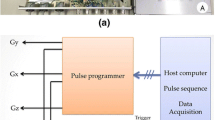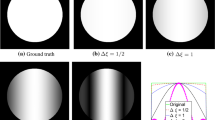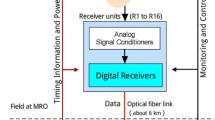Abstract
Object
In this article, two issues pertaining to MRI digital receivers are addressed. One is the maintenance of phase coherence between the transmitter and the receiver—an effective solution is proposed, in which the receiver frequency is switched synchronously with the transmitter frequency. The other is the dynamic range of the receiver—gain-switching technique is utilized to improve the dynamic range. To meet the hardware requirements of these solutions, a digital receiver with fast frequency- and gain-switching capabilities was implemented.
Materials and methods
The primary components of the proposed digital receiver are a variable gain amplifier, a high-speed analog-to-digital converter and a single-chip digital receiver core. The radio-frequency magnetic resonance signal is directly sampled by the analog-to-digital converter and processed in the digital receiver core. By pre-storing the receiver waveform in the on-board SDRAM, the frequency and gain of the receiver may be switched very quickly.
Results
The performance of the proposed digital receiver is verified by embedding it in an imaging spectrometer. It is then demonstrated by conducting experiments on a home-built 0.3-T magnetic resonance imaging system.
Conclusion
The results show that the phase coherence between the transmitter and the receiver and the dynamic range of the receiver are greatly improved. Consequently, the proposed digital receiver may be useful for obtaining multiple-slice two-dimensional magnetic resonance images with very high resolution.
Similar content being viewed by others
References
Wu X, Patterson DA, Butler LG (1993) A broadband nuclear magnetic resonance spectrometer: digital phase shifting and flexible pulse programmer. Rev Sci Instrum 64(5): 1235–1239
Porter JR, Wright SM, Famili N (1994) A four channel time domain multiplexer: a cost–effective alternative to multiple receivers. Magn Reson Med 32(1): 499–504
Wright SM, Brown DG, Porter JR, Spence DC, Esparza E, Cole DC, Huson FR (2001) A desktop magnetic resonance imaging system. Magn Reson Mater Phy 13(3): 177–185
Kose K, Haishi T, Nakanishi A, Okada S, Tsuzaki T (2000) Development of a desktop MR microscopy using a small permanent magnet. Proc Int Soc Magn Reson Med 8: 1380
Haase A, Rokitta A, Rommel E (2001) NMR protable imager. Proc Int Sco Magn Reson Med. Workshop on MRI Hardware, Cleveland, 23–25 February 2001, p 23
Carpenter TA, Williams EJ (1999) MRI—from basic knowledge to advanced strageies: hardware. Eur UADiol 9: 1015–1019
Gengying L, Yu J, Xiaolong Y, Yun J (2001) Digital nuclear magnetic resonance spectrometer. Rev Sci Instrum 72: 4460–4463
Villa M, Tian F, Cofrancesco P, Halamek J, Kasal M (1996) High-resolution digital quadrature detection. Rev Sci Instrum 67: 2123–2129
Gengying L, Haibin X (1999) Digital quadrature detection in nuclear magnetic resonance spectroscopy. Rev Sci Instrum 70: 1511–1513
Kasal M, Halimek J, Husek V (1994) Signal processing in transceivers for nuclear magnetic resonance and imaging. Rev Sci Instrum 65: 1897–1902
Qin X, Jie S, Jianqi L, Gengying L (2005) Compensation for unknown acquisition delay caused by digital receiver without external synchronization in NMR and MRI. Magn Reson Mater Phy 18: 217–224
Carl AM, Kensten B, Elsa H (2002) A high performance digital receiver for home-built nuclear magnetic resonance spectrometers. Rev Sci Instrum 73: 453–458
Behin R, Bishop J, Henkelman RM (2005) Dynamic range requirements for MRI. Concepts Magn Reson B 26: 28–35
Elliott MA, Insko EK, greenman RL, Leigh JS (1998) Improved resolution and signal-to-noise ratio in MRI via enhanced signal digitization. J Magn Reson 130: 300–304
Otake Y, Kose K, Haishi T (2006) A solution to the dynamic range problem in MRI using a parallel image acquisition. Concepts in magnetic resonance Part B. Magn Reson Eng 29(4): 161–167
AD8331(2008) Data sheet, analog devices, Norwood, MA 02062-9106
AD9244 (2005) Data sheet, analog devices, Norwood, MA, 02062-9106
AD6620 (2001) Data sheet, analog devices, Norwood, MA, 02062-9106
XC2S50 (2004) Data sheet, Xillinx, 1-800-255-7788
PCI9052 (1997) Data sheet, PLX technology, 408-774-9060
Jie S, Ying L, Jianqi L, Gengying L (2005) A powerful graphical pulse sequence programming tool for magnetic resonance imaging. Magn Reson Mater Phy 18: 332–342
Author information
Authors and Affiliations
Corresponding authors
Rights and permissions
About this article
Cite this article
Ruipeng, N., Yidong, D., Guang, Y. et al. A digital receiver with fast frequency- and gain-switching capabilities for MRI systems. Magn Reson Mater Phy 22, 333–342 (2009). https://doi.org/10.1007/s10334-009-0182-2
Received:
Revised:
Accepted:
Published:
Issue Date:
DOI: https://doi.org/10.1007/s10334-009-0182-2




